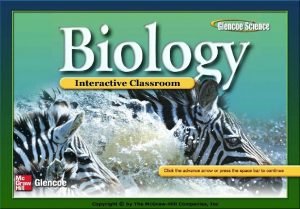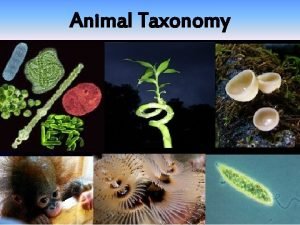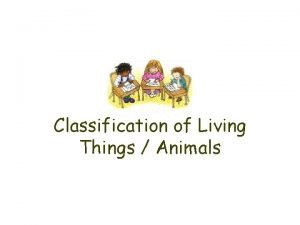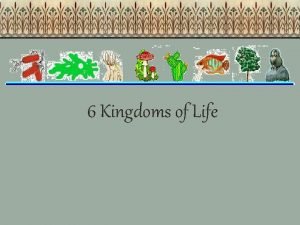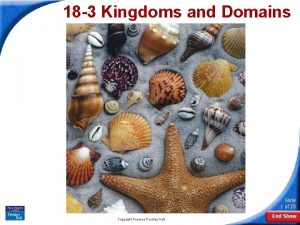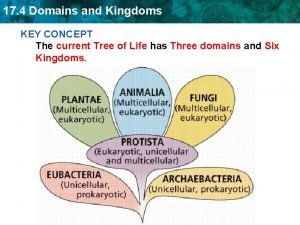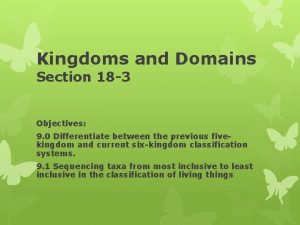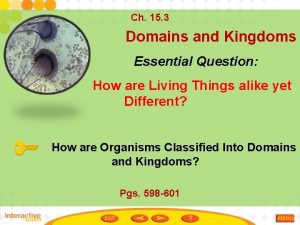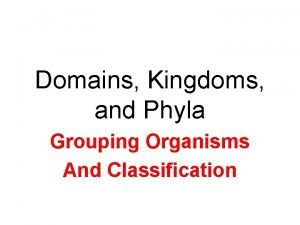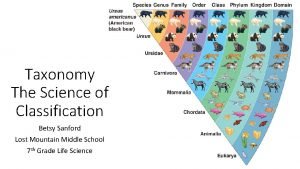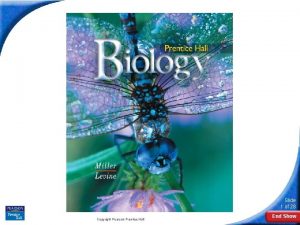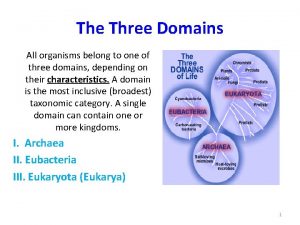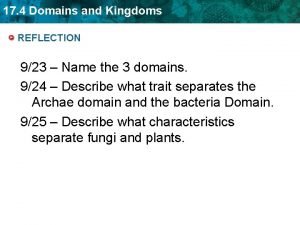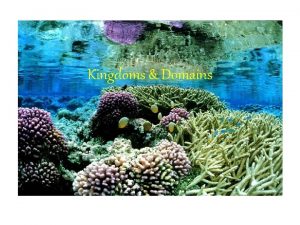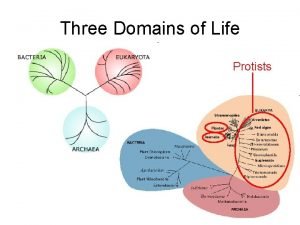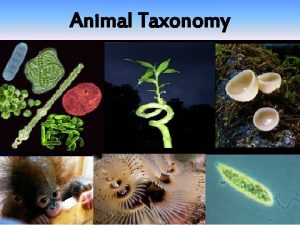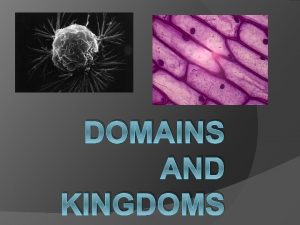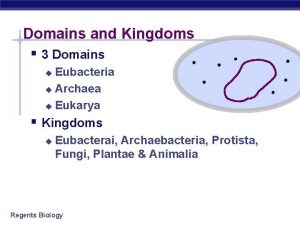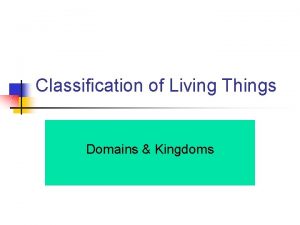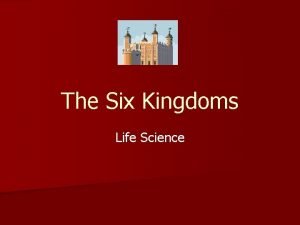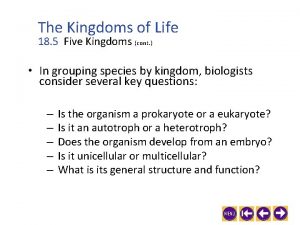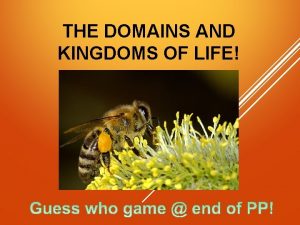KINGDOMS and DOMAINS The Three Domains of Life


















- Slides: 18

KINGDOMS and DOMAINS

The Three Domains of Life • In 1996 Carl Woese added a taxon above kingdom…. These three groups are called Domains. • These three domains are; 1. Eubacteria Prokaryotic Cells 2. Archaea Eukaryotic Cells 3. Eukaryotes -

Learning Goals # 5 - We will be able to describe and distinguish between prokaryotic and eukaryotic cells. #6 – We will be able to identify the three different domains

Two Major Cell Types PROKARYOTIC EUKARYOTIC • Genetic material (DNA) is NOT bound by a membrane • Has one circular chromosome • Membrane-bound organelles are absent • Organisms are UNIcellular • Asexual reproduction is common (binary fission) • Some have simple flagella • DNA is bound by a membrane (Nucleus) • Usually has several chromosomes • Mitochondria and other organelles are present • Most organisms are MULTIcellular • Sexual reproduction is common • Some have flagella

Prokaryotic Cell Eukaryotic Cell diffusion, osmosis, cellular respiration, protein synthesis, digestion, elimination, etc. • same processes must occur in both kinds of cells

PROKARYOTES EUKARYOTES

Kingdoms and Domains The six kingdoms are • Eubacteria • Archaea • Protista • Fungi • Plantae • Animalia If you had to separate these six kingdoms into the three domains, how would you do it? ?


Work Break Complete the Prokaryotes and Eukaryotes Handout

Endosymbiotic Theory

Learning Goal #7 We will be able to describe the endosymbiotic theory.

Where Did Eukaryotic Cells Come From? • Fossil records indicate that eukaryotes evolved from prokaryotes somewhere between 1. 5 to 2 billion years ago. • Evolutionary theory suggests two processes were involved: 1. Membrane Infolding 2. Endosymbiosis

Endocytosis and Exocytosis ENDOCYTOSIS • Method by which cells bring large particles (too big for diffusion) inside. • The cells membrane pinches and wraps around the material (requires ATP) • The wrapped material breaks away forming a VESSICLE. EXOCYTOSIS • cells can rid themselves of material by reversing the process.


The Evolution of Eukaryotic Cells THE ENDOSYBMIOTIC THEORY Theory that explains how eukaryotic cells evolved from the symbiotic relationship between two or more prokaryotic cells. • In endosymbiosis, one cell engulfs a different type of cell, which does not get “digested” but survives and becomes an internal part of the engulfing cell. • It is believed that eukaryotic cell organelles are actually the ancestors of once free-living prokaryotes. • Two organelles support this – the mitochondria and chloroplast.


Evidence for the Endosymbiotic Theory • Both mitochondria and chloroplasts membranes are similar to prokaryote membranes • Ribosomes, in these organelles are much more similar to prokaryotic ribosomes • They reproduce by binary fission within the cell, • Each contains a circular chromosome, and many of the gene sequences closely match those of living prokaryotes. • Many eukaryotic organisms alive today have symbiotic prokaryotes living inside their cells – think of bacteria in our gus!

Work Break Complete Endosymbiotic Theory Handout
 What are the three domains and six kingdoms?
What are the three domains and six kingdoms? Chapter 17 section 1 the history of classification
Chapter 17 section 1 the history of classification Three kingdoms science
Three kingdoms science What are the 3 domains and 6 kingdoms of classification
What are the 3 domains and 6 kingdoms of classification Domain bacteria kingdoms
Domain bacteria kingdoms Chapter 17 domains and kingdoms answer key
Chapter 17 domains and kingdoms answer key Invertebrates animals
Invertebrates animals What are the kingdoms of living things
What are the kingdoms of living things Section 18-3 kingdoms and domains
Section 18-3 kingdoms and domains Concept mapping chapter 17 domains and kingdoms
Concept mapping chapter 17 domains and kingdoms Section 18-3 kingdoms and domains
Section 18-3 kingdoms and domains Flow chart of domains and kingdoms
Flow chart of domains and kingdoms How are organisms classified into domains and kingdoms
How are organisms classified into domains and kingdoms Domains and kingdoms
Domains and kingdoms Domains and kingdoms
Domains and kingdoms Species genus family order
Species genus family order 18-3 kingdoms and domains
18-3 kingdoms and domains Domain of life
Domain of life Domains biology
Domains biology

